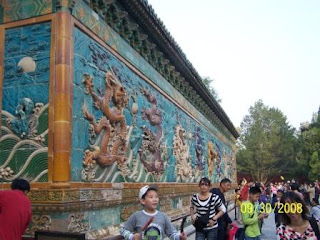
An earlier post about Beihai Park mentioned another and better known highlight of its north end, namely the Nine Dragon Screen. The Chinese name for it is 九龙壁; the first character, a falling/rising tone "jiu," is the word for "nine", the second character, a rising tone "long," is the word for "dragon," and the third character, a falling tone "bi," means cliff. Fellow film buffs will know that the Chinese name for the Hong Kong director John Woo's latest action extravaganza, based on the post Han Dyanasty "Romance of the Three Kingdoms" story, 赤壁, has the character "bi". This is because 壁 means "cliff" as well as "screen", and the film's English title is "Red Cliff". The first character, a fourth tone "chi", is one the three characters for "red" in Mandarin; the other two are 红 (rising tone "hong") and 丹 (falling tone "dan"). I'll say more about this film in another post.
As one can guess from its name, the Nine Dragon Screen depicts ... nine dragons. The screen is 25.78 meters long, 6.65 meters tall, and 1.42 meters thick. The surface is made out of colored, glazed enamel tiles. In addition to being an outstanding example of this kind of art, the screen is unique for having designs on both its font and back sides.
One might ask, "Why have nine dragons? Why not 10 or 6?" The answer to this question is that, as is the case in most things built in China, the screen's design, along with the numbers associated with this design, have symbolic meaning. In this case, the number "nine" was seen as the emperor's number. And in Taoist philosophy, odd numbers are male numbers--hence they go with any kind of male entity or symbol, like the emperor--while even numbers are female numbers. Of course, the latter can also be lucky or fortunate: the number "eight" is a case in point. Thus the 2008 Beijing Olympic Games began eight minutes after eight o'clock on the eighth day of the eighth month of the year, which itself is the eighth year of new century. The Chinese don't have names for months, but instead just put the number of the month in front of character for month, "月," which is a falling tone "yue". The number eight is 八, or a flat tone "ba", so August is 八月, or literally "eight month." No wonder the games were, from an organizational standpoint, a smashing success!
Another significant number are the claws on the dragons' paws. If you look closely at the top photograph, you'll notice that there are five claws. The five claws symbolized the emperor's power. Hence these five-clawed dragons only adorn imperial buildings and garments. This kind of dragon can also be seen in the nine dragon screen that stands in front of the palace built by the 13th son of Hongwu, an early Ming Dynasty Emperor (both "Ming" and "Chao" are rising tones, and the characters are 明朝; "Hong" is a rising tone, "Wu" is a falling/rising tone, and the characters are 洪武). This palace is located at Datong (da is a falling tone, tong a rising tone, and the characters are 大同) in Shanxi Province. Shan and xi are both flat tones, the characters are 山西, and they literally mean "west of the mountain".
Perhaps the most notable feature of these dragons is their playful demenaor. Looking closely at the top photo, you'll see a ball shaped object between the two dragons. That's a pearl ball and the Chinese friend mentioned in my last blog post, Lu Hong Yan, informed me, during an earlier visit to Beihai Park, that dragons play with each other by passing pearl balls back and forth from their mouths.
This depiction of dragons is, of course, very different from the Western view of these mythical creatures. Chinese dragons are not evil, fire-breathing monsters spreading death and destruction. As one of my best Chinese friends from my first year in the Middle Kingdom, a lovely woman from Inner Mongolia named 杨蕾 (rising tone Yang and flat tone Lei), once told me, dragons here are seen as magical and benevolent creatures. In particular, they are believed to be the bearers of good fortune, bringing rainfall to increase crop harvests and warding off evil spirits. So there's no figure comparable to St. George the Dragon Slayer in old Chinese literature!
The top photo shows just one end of the Nine Dragon Screen. Another photo, showing the entire screen, is posted below.

No comments:
Post a Comment